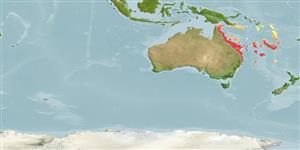>
Eupercaria/misc (Various families in series Eupercaria) >
Lutjanidae (Snappers) > Lutjaninae
Etymology: Lutjanus: Malay, ikan lutjan, name of a fish.
More on author: Castelnau.
Environment: milieu / climate zone / depth range / distribution range
Ecologie
marien rifbewoner; diepte ? - 20 m (Ref. 9710). Subtropical; 10°S - 37°S, 143°E - 170°E (Ref. 55)
Western Pacific: restricted to the east coast of Australia and New Caledonia. The main Australian distribution is off southern Queensland between Cape Moreton (about 27°S) and the Capricorn Group(23°S). This species has been usually referred to as Lutjanus amabilis by previous authors.
Lengte bij maturiteit / Grootte / Gewicht / Leeftijd
Maturity: Lm 25.0, range 20 - 30 cm
Max length : 50.0 cm TL mannelijk / geslacht onbekend; (Ref. 55); common length : 30.0 cm TL mannelijk / geslacht onbekend; (Ref. 55); max. gerapporteerde leeftijd: 40 Jaren (Ref. 2290)
Dorsale stekels (totaal) : 10; Dorsale zachte stralen (totaal) : 14; Anale stekels: 3; Anale zachte stralen: 8. Snout somewhat pointed. Preopercular notch and knob moderately well developed. Scale rows on back rising obliquely above lateral line. Generally pale blue-gray to whitish with suffusion of yellow on upper back. A prominent golden brown stripe, slightly narrower than the eye, runs laterally from the rear edge of the of the opercle to the caudal peduncle.
Adults mainly inhabit coral reefs. Sometimes forming large aggregations around rocky outcrops during daylight hours. They disperse to feed at night (Ref. 9710). Usually marketed fresh.
Levenscyclus en paargedrag
Maturities | Voortplanting | Spawnings | Egg(s) | Fecundities | Larven
Allen, G.R., 1985. FAO Species Catalogue. Vol. 6. Snappers of the world. An annotated and illustrated catalogue of lutjanid species known to date. FAO Fish. Synop. 125(6):208 p. Rome: FAO. (Ref. 55)
Status op de Rode Lijst van het IUCN (Ref. 130435)
Gevaar voor de mens
Harmless
Gebruik door de mens
Visserij: van minder commercieel belang; sportvis: ja
Tools
Speciale rapporten
Download XML
Internetbronnen
Estimates based on models
Preferred temperature (Ref.
123201): 23.3 - 27.9, mean 25.9 °C (based on 303 cells).
Fylogenetische diversiteitsindex (Ref.
82804): PD
50 = 0.5000 [Uniqueness, from 0.5 = low to 2.0 = high].
Bayesian length-weight: a=0.01413 (0.00930 - 0.02146), b=3.02 (2.90 - 3.14), in cm total length, based on LWR estimates for this species & Genus-body shape (Ref.
93245).
Trofisch niveau (Ref.
69278): 3.7 ±0.0 se; based on diet studies.
Weerstandsvermogen (Ref.
120179): Gemiddeld, minimale populatieverdubbelingstijd 1,4-4,4 jaar (K=0.26-0.34; tmax=40).
Fishing Vulnerability (Ref.
59153): Moderate vulnerability (38 of 100).
Nutrients (Ref.
124155): Calcium = 23.7 [11.7, 37.8] mg/100g; Iron = 0.33 [0.19, 0.58] mg/100g; Protein = 19.2 [17.6, 20.6] %; Omega3 = 0.172 [0.101, 0.297] g/100g; Selenium = 22.1 [11.5, 43.5] μg/100g; VitaminA = 87.1 [15.3, 429.9] μg/100g; Zinc = 0.324 [0.228, 0.511] mg/100g (wet weight);
